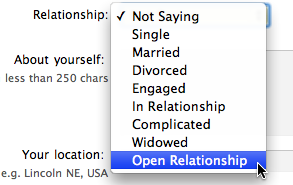Heart
"heart" is an ActivityStreams verb under research and consideration per the process. so named because of the "heart" ♥ symbol in the way such actions are displayed on common services like Facebook.
Why
Research of Examples
Examples of "heart" activities, i.e. relationship status updates on existing sites:
Facebook
Facebook highlights changes in relationship status with a specific look+feel, namely by doing two things:
- moving it to the top of other status updates (even more recent)
- leading it with a red heart graphic
Examples of activity items we want to represent with this new verb:
♥ Sally is single. (Comment) (Like)
♥ John is in a relationship. (Comment) (Like)
♥ John is in a relationship with Dana. (Comment) (Like)
Screenshots:


MySpace
Does MySpace show changes of relationship as an activity in a user's updates?
Monica: I don't think so but we should look at dating sites like Zoosk, Match.com, eHarmony if they have streams they may focus on their members finding love
Relationship Status Examples
Relationship status itself is not an activity, but rather more of an attribute of the person. Thus I'm documenting these on the microformats wiki since relationship status may make sense as an addition to hCard. I've left a few here in line as examples. Please feel free to add more examples here and/or on the microformats wiki (preferably). -Tantek
http://microformats.org/wiki/relationship-status
Socialight
Socialight has relationship status in their UI, but no examples have been provided of "heart" activities, that is, of their UI showing relationship status *changes* - which is what the activity would be.

Plurk
Plurk has relationship status in their UI, but no examples have been provided of "heart" activities, that is, of their UI showing relationship status *changes* - which is what the activity would be.

See http://microformats.org/wiki/relationship-status for more relationship status examples.
Verb name brainstorms
"heart" is just a placeholder based on the typical presentation shown above. let's come up with some better alternatives for this verb:
Monica: Ok. Yes heart does not really make sense for this activity. I thought you were using to say I heart Pizza.
- The proper verb would be "date" or "to date" and it should be done between 2 people sorry lets not get freaky with the I can date anything
- Also need "married", "engaged to", "become single"
- ...
Do we need different verbs for all of these? (is single/married/engaged)
Or can we introduce just one verb (since all of them are presented similarly) with details?
- "update-relationship" - I realize this is similar to the existing Update verb, however, given the difference in user interface that is presented for relationship updates this is a suggested new verb name. Comments/criticisms welcome on naming conventions, inclusion of general direct-object in name etc.
- Would it make more sense to simply "Update" (verb) "Relationship" (object)? In this case Relationship is an object with the properties "relation-type" and an optional person object. This maps reasonably well to the actor/verb/object model.
Relationship status update brainstorms
Here is a brainstorm about how a relationship status update could be represented using the *existing* "update" verb, and "status" direct-object with perhaps just an additional enum.
JSON representation as originally posted by Monica on the mailing list:
{
"actor" : {"id":1212, "displayName" : "Peter"},
"verb" : "update",
"change" :
{
"name" : "relationship status",
"value" : {"$ref": "#object.relationship.status"}
},
"object" : {
"id": 1212,
"displayName" : "Peter",
"objectType" : "person",
"relationship" : {
"status" : "married", /* Use your enum here */
"to" : {"id":"878787", "displayName" : "Sally", "type" :
"person"}
}
}
}
How would this work in an Atom representation?
(Work in progress - please feel free to contribute / help refine - goal is a sample Atom <entry> element with all the necessary elements inside to represent the semantics of this activity)
In Atom:
- the actor is implicitly the AUTHOR of the ENTRY
- the verb is "update" - need sample Atom markup for a verb. O_o
- the object-type is "status" - thus inside the ENTRY:
- ... more details ...
Relationship status brainstorms
Whatever the verb is, the direct-object or perhaps the details of the verb should be based upon existing publishing practices. Thus it may help to have an enumerated list of possible named direct-objects.
I've moved my brainstorms from this section to the microformats wiki, since the relationship status itself is more related to a person than an activity. -Tantek
http://microformats.org/wiki/relationship-status
Return to Verbs \ FrontPage
Comments (2)
Monica Wilkinson said
at 10:28 am on Jul 24, 2010
Also this could be an object-less activity. Example: Peter is dating. Mary is married or Mary is married to Peter
Chris Messina said
at 6:48 pm on Aug 10, 2010
The problem with this "activity" is that it's a state-change, not really an activity in the conventional sense, where there's some object.
There is an indirect object or target, but that's not really how that feature was intended.
This definitely requires further consideration and may expose a limitation in the current actor-verb-object model.
You don't have permission to comment on this page.